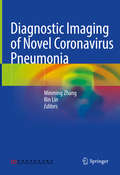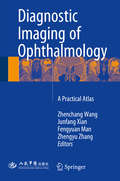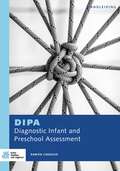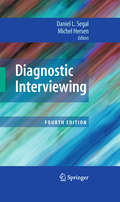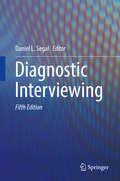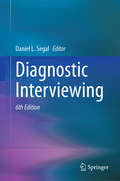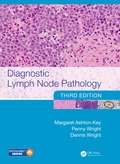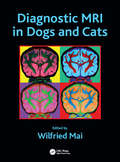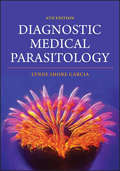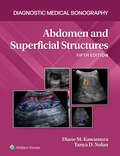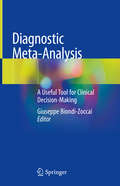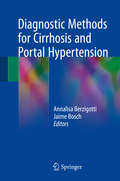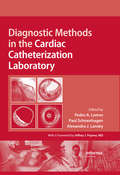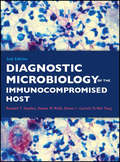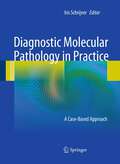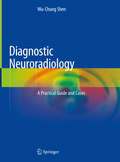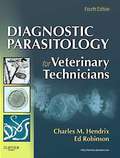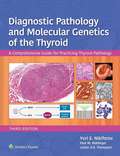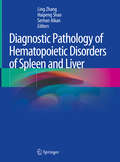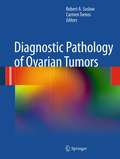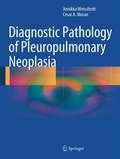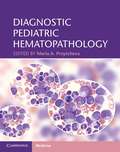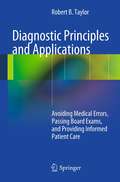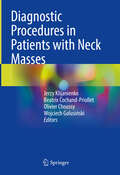- Table View
- List View
Diagnostic Imaging of Novel Coronavirus Pneumonia
by Minming Zhang Bin LinThis book presents radiological findings in patients with 2019 Novel Coronavirus Pneumonia (COVID-19). It starts with a general review of COVID-19 Pneumonia discovery, including etiology characteristics, transmission routes and pathogenic mechanisms. In the following chapters, details in clinical classification, imaging manifestations in different groups, and imaging features of family aggregated coronavirus pneumonia are introduced. In addition, key points in differential diagnosis of COVID-19 Pneumonia are summarized in the last chapter. The book provides a valuable reference source for radiologists and doctors working in the area of COVID-19 Pneumonia.
Diagnostic Imaging of Ophthalmology
by Zhenchang Wang Junfang Xian Fengyuan Man Zhengyu ZhangThis atlas is a pocket manual of imaging diagnosis of the orbital. It includes common imaging techniques, normal imaging features, abnormal orbital imaging of developmental diseases, injury, inflammation, lymphoproliferative diseases, diseases of the eyeball, post-operative changes, vascular diseases, tumors and neuro-ophthalmological diseases. While it particularly focuses on CT and MRI, it also describes other techniques, such as X-ray, ultrasonography and nuclear imaging. The book starts with an overview of commonly used imaging techniques of the orbit a concise description of imaging features of normal orbit in X-ray, CT and MRI. The following nine chapters explore different orbital diseases and abnormalities that are common in clinical work. It is a valuable resource for radiologists and ophthalmologists.
Diagnostic Infant and Preschool Assessment DIPA handleiding
by Ramon LindauerDe Diagnostic Infant and Preschool Assessment (DIPA) is een semigestructureerd klinisch interview waarmee de psychopathologie van kinderen in de leeftijd van één tot en met zeven jaar in beeld kan worden gebracht. Met de DIPA kunnen de volgende psychische stoornissen volgens de DSM-5-classificatie worden vastgesteld: posttraumatische-stressstoornis, depressieve stoornis, disruptieve stemmings-disregulatiestoornis, aandachtsdeficientie-/hyperacitiviteitsstoornissen, oppositioneel-opstandige stoornis, normoverschrijdend-gedragsstoornis, separatieangststoornis, specifieke fobie, sociale-angststoornis, gegeneraliseerde-angststoornis, obsessieve-compulsieve stoornis, reactieve hechtingsstoornis, ontremd-sociaalcontactstoornis, en problemen met in- en doorslapen.Met de DIPA worden de frequentie, intensiteit, duur, start en interferentie van de symptomen vastgesteld. De DIPA is ook uitermate geschikt om behandeleffecten te meten. Het interview wordt afgenomen bij ouders of andere primaire verzorgers door psychologen, orthopedagogen, kinder- en jeugdpsychiaters en andere professionals met ruime klinische ervaring met psychodiagnostiek bij jonge kinderen.
Diagnostic Interviewing
by Michel Hersen Daniel L. SegalThis volume represents a clear, jargon-free overview of diagnostic categories with helpful hints regarding a psychiatric interview. Completely revised and updated, detailing current innovations in theory and practice, including recent changes in the DSM-IV.
Diagnostic Interviewing
by Daniel L. SegalThis volume represents a clear, jargon-free overview of diagnostic categories with helpful hints regarding a psychiatric interview. Completely revised and updated, detailing current innovations in theory and practice, including recent changes in the DSM-IV.
Diagnostic Interviewing
by Daniel L. SegalA cornerstone of the professional therapeutic relationship and a vital prerequisite to effective treatment, the diagnostic interview sets the tone for interventions that follow. This welcome update to the authoritative textbook includes coverage of foundational and advanced skills and strategies for effective clinical and diagnostic interviewing. Completely revised and updated to correspond to the DSM-5-TR and to reflect the latest innovations in theory and evidence-based practice, this instructive book offers a wealth of useful interviewing strategies and techniques. Specific interviewing approaches are discussed for diverse settings and diverse clients across a variety of presenting problems and mental disorders, as well as keys to ensuring that the interview process is effective and clinically sound. As with its predecessors, this volume emphasizes the value of the interview as the foundation for treatment planning, intervention, and the healing therapeutic relationship. Among the topics covered: Ethical and professional issues. Interviewing strategies, rapport, and empathy. Presenting problem, history of presenting problem, and social history. The mental status examination. Consideration of neuropsychological factors in interviewing. Specific disorders including depressive disorders, bipolar disorders, anxiety disorders, obsessive-compulsive and related disorders, trauma and stressor-related disorders, dissociative disorders, somatic symptom disorders, eating disorders, sexual dysfunctions and gender dysphoria, substance use disorders, personality disorders, and schizophrenia spectrum disorders. Special populations, including children, older adults, interviewing in health, medical, and integrated care settings, and interviewing individuals at risk for suicide. Previous editions of Diagnostic Interviewing have been used in the training and education of diverse mental health professionals including psychologists, psychiatrists, social workers, marriage and family therapists, and professional counsellors. This Sixth Edition will continue this tradition, aiding students, new practitioners, and seasoned clinicians.
Diagnostic Lymph Node Pathology
by Margaret Ashton-Key Penny Wright Dennis WrightDiagnostic Lymph Node Pathology presents a logical and systematic approach to lymph node biopsies and guides general pathologists and haematopathologists alike through the maze of differential diagnoses, enabling them to reach an accurate diagnosis. The book is presented in an easy-to-read format and contains boxes for quick reference detailing the clinical, morphological, immunohistochemical, and genetic features of each entity. Thoroughly revised, the third edition also includes more than 300 high-quality histological colour photographs along with updated references. This edition covers both classical and less well-known features of individual disease processes. It is a valuable guide for both professionals and trainees.
Diagnostic MRI in Dogs and Cats
by Wilfried MaiDiagnostic MRI in Dogs and Cats makes the vast and increasingly complex topic of clinical MRI in small animals accessible to all veterinarians. With the increasing availability of MRI technology, there is also a pressing need for expertise in interpreting these images. This is the first reference textbook to provide a well-illustrated and comprehensive overview of the current knowledge, focusing on imaging appearance rather than on clinical signs or treatment. With chapters on MRI physics and technology as well as sections on specific anatomical regions, the book functions as a stand-alone reference for the reader, whether they be a radiology/neurology resident in training or a practitioner with a need to learn about veterinary clinical MRI. <li>Includes both evidenced-based material and the authors' personal experience, providing an excellent overview of current knowledge in the field. <li>Contributors are international leaders in the field. <li>Bullet points format and table summaries throughout the book keep the concepts concise and organized. <li>Richly illustrated with over 650 annotated images showcasing the main features of the disease processes. <li>Images are obtained at all magnet field strengths, so as to reflect the current reality of veterinary MRI, which uses low-, mid- and high-field magnets. <P><P>The chapters on physics and MRI technology are concise and accessible, using many visual aids and diagrams, and avoiding abstract concepts and equations whenever possible. Within each anatomical section, each chapter focuses on a disease category of that body region. When it is important to understand the imaging appearance, the pathophysiology is reviewed and imaging features of prognostic relevance are detailed. This practical yet thoroughly comprehensive book is primarily an evidence-based learning resource for trainees, but will also aid practising veterinarians who have less MRI experience.
Diagnostic Medical Parasitology (ASM Books #49)
by Lynne GarciaDiagnostic Medical Parasitology covers all aspects of human medical parasitology and provides detailed, comprehensive, relevant diagnostic methods in one volume. The new edition incorporates newly recognized parasites, discusses new and improved diagnostic methods, and covers relevant regulatory requirements and has expanded sections detailing artifact material and histological diagnosis, supplemented with color images throughout the text.
Diagnostic Medical Sonography Series: Abdomen and Superficial Structures
by Diane Kawamura Tanya NolanPart of the highly regarded Diagnostic Medical Sonography series, Diane M. Kawamura and Tanya D. Nolan’s Abdomen and Superficial Structures, 5th Edition, thoroughly covers the core content students need to master in today’s rigorous sonography programs. Careful, collaborative editing ensures consistency across all three titles in this series: The Vascular System, Abdomen and Superficial Structures, and Obstetrics and Gynecology, providing the right content at the right level for both students and instructors.
Diagnostic Meta-Analysis: A Useful Tool for Clinical Decision-Making
by Giuseppe Biondi-ZoccaiThis book is the first exclusively devoted to the systematic synthesis of diagnostic test accuracy studies. It builds upon the major recent developments in reporting standards, search methods, and, in particular, statistical tools specifically devoted to diagnostic studies. In addition, it borrows extensively from the latest advances in systematic reviews and meta-analyses of intervention studies. After a section dedicated to methods for designing reviews, synthesizing evidence and appraising inconsistency in research, the application of these approaches is demonstrated in the context of case studies from various clinical disciplines. Diagnosis is central in medical decision-making, and in many other fields of human endeavor, such as education and psychology. The plurality of sources of evidence on diagnostic test accuracy poses a huge challenge for practitioners and researchers, as do the multiple dimensions of evidence validity, which include sensitivity, specificity, predictive values, and likelihood ratios. This book offers an invaluable resource for anyone aiming to improve decision-making processes in diagnosis, classification or risk prognostication, from epidemiologists to biostatisticians, radiologists, laboratory physicians and graduate students, as any physician interested in refining his methodological skills in clinical diagnosis.
Diagnostic Methods for Cirrhosis and Portal Hypertension
by Jaime Bosch Annalisa BerzigottiThis book provides a unique up-to-date and comprehensive overview of the most important diagnostic methods available for assessing liver cirrhosis and portal hypertension. The book covers all the significant advances made in the last 10 years in HVPG and biopsy interpretation, imaging and elastography. This is a unique and well structured book authored by senior experts in the field aimed at providing updated knowledge to the hepatology specialist and to the physicians interested in chronic liver disease. The book starts by giving an overview of the disease, outlining the clinical needs in this field; this is followed by detailed information both on the invasive gold-standard methods (HVPG measurement, liver biopsy, endoscopy), and on the standard and emerging non-invasive methods, including serum markers of fibrosis, ultrasound-elastography, magnetic resonance elastography, ultrasound, contrast-enhanced ultrasound, CT, magnetic resonance and derived methods (dynamic flow assessment). The final part of the book is devoted to diagnostic tests in non-cirrhotic causes of portal hypertension (Budd-Chiari Syndrome, Portal vein thrombosis, idiopathic portal hypertension, etc), and in pediatric portal hypertension.Written by a team of worldwide opinion leaders this book pays special attention to the most promising novel non-invasive methods in the field.
Diagnostic Methods in the Cardiac Catheterization Laboratory
by Paul Schoenhagen Pedro A. Lemos Alexandra J. LanskyThe tools necessary for correctly identifying complex coronary lesions and plaques. The data required to accurately diagnose rare disease progression and patterns. With Diagnostic Methods in the Cardiac Catheterization Laboratory, all of the essential diagnostic modalities you need in the lab are at your fingertips. This new force in cardiology is
Diagnostic Microbiology of the Immunocompromised Host (ASM Books)
by Yi-Wei Tang Karen Carroll Randall Hayden Donna WolkStrategies for providing optimal care to this high-risk patient group The immunocompromised patient population is increasing throughout the world. Major advances in transplantation techniques have expanded access to lifesaving therapies and improved outcomes in these high-risk populations. An understanding of the biology of these infections, host conditions, and the limitations of technologies used to detect and quantify such pathogens is critical to optimal care. This new edition of Diagnostic Microbiology of the Immunocompromised Host covers all aspects of state-of-the-art diagnostics for infectious complications in the immunocompromised patient. Editors Randall Hayden, Karen Carroll, Yi-Wei Tang and Donna Wolk, assembled the contributions of a team of preeminent authors to discuss a broad range of topics, including relevant aspects of host biology, antineoplastic, and transplantation techniques and the basis of immunosuppressive conditions ranging from diabetes to age-related immunosuppression approaches, interpretations, and limitations of laboratory diagnosis of infections by a wide range of specific etiologic agents laboratory diagnosis of infections of specific organ systems, such as respiratory tract infections, gastrointestinal tract infections, and central nervous system infections special topics such as prosthetic devices and catheters, healthcare acquired infections, and morphologic considerations (anatomic pathology) future diagnostic technologies and their potential impact on the field Diagnostic Microbiology of the Immunocompromised Host is a resource for laboratory medicine specialists, pathologists, technologists, students, and clinical care professionals who are involved or interested in the care of the immunocompromised host.
Diagnostic Molecular Pathology in Practice
by Iris SchrijverThis entirely case-based book covers a broad cross-section of the practical issues frequently encountered in the day-to-day activities of a molecular genetic pathologist. The book is divided into four sections on the principal areas addressed in molecular genetic pathology (MGP): inherited diseases, hematopathology, solid tumors, and infectious diseases. The topics covered by the cases in each section include test selection, qualitative and quantitative laboratory techniques, test interpretation, prognostic and therapeutic considerations, ethical considerations, technical troubleshooting, and result reporting. This book will be ideal for trainees in MGP and clinical molecular genetics who require a practice-based preparation for board examinations. It will also be very useful for residents and fellows in medical specialties to which MGP is pertinent, and for practicing pathologists who want to learn more about the current practice of molecular diagnostics.
Diagnostic Neuroradiology: A Practical Guide and Cases
by Wu-Chung ShenCT and MRI are two of the most important tools in diagnostic neuroradiology. This book will help readers identify key features of CT and MRI images of various common brain and spine diseases and make rapid diagnoses. It presents comprehensive information, including more than 2,000 illustrative CT and MRI images, accompanied by concise and easy-to-use tips based on the author’s 40 years of teaching and clinical experience. Helping them improve their CT and MRI image interpretation skills in connection with head injuries, stroke, intracranial tumors, CNS infections, and spinal diseases, this book offers a valuable reference guide not only for residents and fellows in neuroradiology and radiology, but also for medical physicians, medical students, and other specialists interested in diagnostic neuroradiology.
Diagnostic Parasitology for Veterinary Technicians (4th Edition)
by Charles M. Hendrix Ed RobinsonCovering dogs and cats, ruminants, horses, swine, birds, rabbits, laboratory animals, and fish, Diagnostic Parasitology for Veterinary Technicians, 4th Edition features clear and concise discussions of the most commonly encountered internal and external parasites. In full-color, with a convenient spiral binding, this resource offers step-by-step guidelines for collecting samples and performing lab procedures. Comprehensive terminology coverage familiarizes you with the language of parasitology for effective communication with other members of the veterinary team, and the enhanced life cycle coverage helps you educate clients about prevention and control strategies. Clear and concise coverage of the most commonly encountered internal and external parasites provides an accessible, informative resource for veterinarians, technicians and students alike. Full-color images of parasites ease your ability to recognize parasites in lab samples. Appendix of parasites for each species shows their location and makes it easy to find discussions on every specific parasite. Chapter on lab procedures offers step-by-step guidelines for gathering samples and performing lab procedures. Emphasis on zoonotic potential of parasites helps you alert other health care workers and clients on ways to prevent transmission of a zoonotic parasite, condition, or syndrome from animals to humans. Basic chapter on terminology familiarizes you with the language of parasitology for more effective communication with clients and colleagues. Heartworm section offers insights on performing and interpreting heartworm diagnostic tests to help you recognize and treat this major parasite. Additional tables of parasites - cross-referencing such categories as body systems affected, taxonomic grouping, host species, and location in host - ensure that you understand the countless ways of categorizing parasites. Consistent presentation of information on individual parasites - including common name, size and location of adult, size of egg, and importance (such as disease condition caused by the parasite adult/egg) - helps you quickly locate vital data. Detailed coverage of parasite life cycles includes additional life cycle drawings to help you easily communicate prevention and control strategies to clients. New pictures of pseudoparasites (yeast cells, pollen grains, plant cells) help you recognize pseudoparasites and understand how they differ from parasites. Expanded chapter on exotics offers more images and detailed discussions of the parasites that affect exotics animals. Vet Tech Threads include chapter outlines, key terms, chapter quizzes, and Technician Notes, to help you focus on key concepts. Online resources on Evolve include an image collection and electronic flash cards for a visual and interactive learning experience.
Diagnostic Pathology and Molecular Genetics of the Thyroid: A Comprehensive Guide for Practicing Thyroid Pathology
by Yuri E. Nikiforov Paul W. Biddinger Lester D.R. ThompsonPublisher's Note: Products purchased from 3rd Party sellers are not guaranteed by the Publisher for quality, authenticity, or access to any online entitlements included with the product. Offering a comprehensive overview of the diagnostic surgical pathology, cytopathology, immunohistochemistry and molecular genetics of the thyroid diseases, this updated reference now incorporates recent, groundbreaking studies and major changes in the field. Global experts provide a complete guide to all diagnoses alongside major advances in tumor staging, immunohistochemistry and molecular genetics, helping you effectively evaluate thyroid tumors and non-neoplastic diseases.
Diagnostic Pathology of Hematopoietic Disorders of Spleen and Liver
by Ling Zhang Haipeng Shao Serhan AlkanThis book provides a comprehensive and up-to-date overview of the pathologic features of common benign and malignant hematopoietic disorders in spleen and liver for practicing pathologists, hematopathologists and clinicians. The authors are from large academic centers, affiliated teaching hospitals and central referral clinics and are experienced in the diagnosis of hematopoietic disorders in the spleen and liver. The book consists of 21 chapters, with the first three chapters devoted to normal histologic features, conventional, cytogenetic and molecular studies necessary for the diagnosis of hematopoietic disorders in the spleen and liver. Chapters 4 to 17 cover the primary and secondary mature B- and T/NK cell lymphomas, Hodgkin lymphoma, B and T cell lymphoblastic leukemias, myeloid neoplasms, histiocytic and dendritic neoplasms, and post-transplant disorders including post transplant lymphoproliferative disorders. Chapters 19 to 21 encompass red blood cell disorders, other benign hematologic disorders and infectious/inflammatory disorders that could mimic hematopoietic neoplasms. These chapters are formatted on specific hematopoietic neoplasms to comprise epidemiology, etiology, pathogenesis, morphology, immunophenotyping, molecular genetics, prognosis and brief treatment guidelines. Diagnostic caveats are included in order to have a quick review of the key points in each chapter.Diagnostic Pathology of Hematopoietic Disorders of Spleen and Liver covers most, if not all of the benign and malignant hematopoietic disorders in the spleen and liver and serves as a practical and useful resource for general pathologists and hematopathologists.
Diagnostic Pathology of Ovarian Tumors
by Robert A. Soslow Carmen TornosDiagnostic Pathology of Ovarian Tumors offers a focus on the pathology of ovarian neoplasia with detailed clinically relevant information for practicing pathologists not found in other more general volumes of gynecologic pathology. This important work focuses almost entirely on strategies for accurate diagnosis and histologic subclassification, and the clinical correlates of these diagnosis. It provides evolving guidelines for detecting early ovarian cancer in prophylactic specimens; cutting-edge information on enhancing the reproducible and clinically meaningful subclassification of ovarian carcinoma as well as new proposals for ovarian carcinoma grading. Richly illustrated, containing abundant tables and figures as well as bulleted points of information, Diagnostic Pathology of Ovarian Tumors is the first text offering chapters written by practicing gynecologists on how clinical data can enhance pathologic diagnostic accuracy, how pathologists can efficiently convey their diagnostic opinions to gynecologists, and the way in which a given diagnosis triggers a cascade of clinical testing and therapy. Diagnostic Pathology of Ovarian Tumors will be of great value to practicing surgical pathologists, including gynecologic pathologists, pathology residents in training, as well as gynecologic and medical oncologists worldwide.
Diagnostic Pathology of Pleuropulmonary Neoplasia
by Annikka Weissferdt Cesar A. MoranDiagnostic Pathology of Pleuropulmonary Neoplasia highlights the morphologic basis, immunohistochemistry, electron microscopy, and molecular biology of tumoral and pseudotumoral conditions of the lung and pleura. The volume also highlights the nuances in the diagnosis of lung and pleural conditions and the applications of today's most recent studies in molecular biology, and the way it is applied to diagnosis and treatment. In providing an expert guide for the histopathologic diagnosis of lung and pleural tumors, this volume be of great interest to general surgical pathologists, surgeons, oncologists, and those involved in the management of patients with lung tumors.
Diagnostic Pediatric Hematopathology
by Maria A. ProytchevaDiagnostic Pediatric Hematopathology is unique in providing an accurate and up-to-date guide to the diagnosis of benign and malignant hematologic disorders of childhood. The text discusses the development of the hematopoietic and lymphoid systems - and how this affects normal and abnormal findings in children at various ages. Also examined are the morphologic, immunophenotypic, cytogenetic, and molecular genetic characteristics of most pediatric-specific hematologic diseases. This is an excellent reference that ensures accurate diagnoses when evaluating peripheral blood, bone marrow, and lymph nodes of children. The text is written by a team of experienced pediatric hematopathologists and clinical scientists drawn from major academic children's hospitals in the United States, Europe, and Canada. It will be a valuable tool in the every day practice of pathologists, pediatric pathologists, and hematopathologists, and a ready educational resource for fellows, pathology residents, medical students, clinical scientists in the field, and pediatric hematologists/oncologists.
Diagnostic Principles and Applications
by Robert B. TaylorThis book fills the need for a resource presenting important diagnostic facts that clinicians should have learned during their classroom lectures and subsequent clinical training, but often didn't. The content will be literature-based information that can help the clinician avoid diagnostic errors. Most other diagnosis books on the market are either "physical diagnosis" texts targeting student readers or "differential diagnosis" books intended for use by practicing physicians, though both types of books aim to be comprehensive. What sets this book apart from other diagnosis books is that it is a curated collection of facts, tailored specifically to address common gaps in clinical knowledge and describe less-traveled pathways to important diagnostic destinations. This book focuses on high-impact techniques. Essential Diagnostic Facts Every Clinician Should Know contains: -Classical diagnostic pearls clinicians should have learned in physical diagnosis courses. For example, a patient with acute pericarditis may find that leaning forward relieves the pain. -Red flag symptoms of serious disease. For example, an infant that tastes salty when kissed might be the first clue to a diagnosis of cystic fibrosis. -Pathognomonic signs allowing an occasional early diagnosis: For example, Koplik spots in a febrile child are found only with measles. -Plastic pearls exposed: For example, contrary to clinical lore, back pain at night has not been found to be a useful indicator for serious spinal pathology. -Counterintuitive clinical manifestations: For example, the patient with gout may have a normal or even low serum uric acid level during an acute attack. -Clinical manifestations that may point to uncommon diagnoses: For example, nocturnal bone pain, sometimes dramatically relieved by aspirin, characterizes osteoid osteoma.
Diagnostic Procedures in Patients with Neck Masses
by Jerzy Klijanienko Wojciech Golusiński Beatrix Cochand-Priollet Olivier ChoussyThis book gathers the consensus recommendations on diagnostic procedures in patients with neck masses by the European Head and Neck Society, European Federation of Cytology Societies, European Society of Hybrid Imaging and International Melanoma Pathology Study Group. Because of the variability of anatomical structures and the richness of histological tissues, the diagnostic process for neck masses is often complex. The diagnostic process depends on the habits of oncological centers, the experience of specialists and particular standards. In reality, there is no international recommendations which would allow to define the optimal and least invasive modalities for carrying out a rapid and accurate diagnosis. Written by the most eminent specialists of different profiles and geographic areas, who present and analyze different technical modalities, the book combines the different points of view and defines the agreed upon optimal technique. Each chapter is short, informative, well referenced and the main messages are placed in tables and boxes. The book is addressed to oncologists, radiologists, nuclear physicians, ENT surgeons, surgical- and cyto-pathologists. This work is under the patronage of the International Academy of Cytoloy (IAC).
Diagnostic Protocols in Endocrinology
by Sanjay Bhadada Liza Das Rimesh PalEndocrinology is perhaps, the only branch of medicine where stimulation and suppression testing are required as the initial step for biochemical confirmation of the clinical condition as hormone secretion is pulsatile. One of the primary needs for an endocrinologist is a pocketbook that can serve as a guide for performing and interpreting these tests. Unfortunately, there is no single source of these protocols, procedures, and interpretation of these tests in the country or even in the Southeast Asia region. This protocol manual is designed to be a ‘ready reckoner’ for endocrinologists for performing these tests. Disorders of various endocrine glands, including pituitary, thyroid, pancreas, adrenal, gonads, and bone and mineral disorders, have been addressed. The book includes prerequisites and indications of a given test, principles of the testing, detailed procedure, and interpretation. Participant information and instruction sheets have been included, when applicable, to be given as a handout to patients prior to these tests. The manual contains algorithms (e.g., for approaching cases with hypoglycemia) and interpretation provided in a tabular format. It also lists troubleshooting measures for specific tests, when applicable. Further, clinical case scenarios substantiated by clinical and radiological images have been incorporated in the manual to highlight the procedure and interpretation of these tests in the management of challenging clinical cases. The manual is designed to be a comprehensive yet concise document covering all these aspects. Besides blood-based investigations, procedures which are undertaken in challenging endocrine scenarios, including inferior petrosal sinus sampling, and adrenal venous sampling have been elucidated in a crisp and practical manner.
